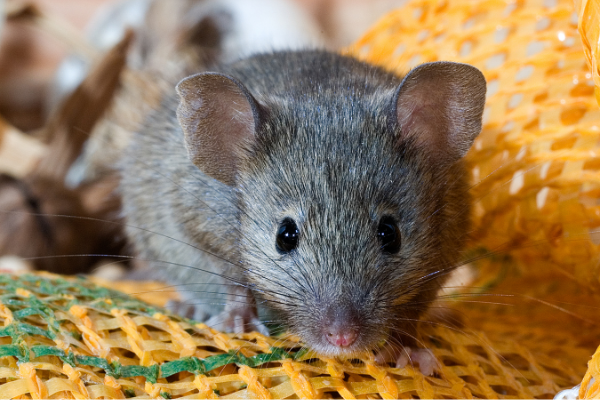
The house mouse (Mus musculus) is a small mammal of the order Rodentia, characteristically having a pointed snout, large rounded ears, and a long and hairy tail. It is one of the most abundant species of the genus Mus. Although a wild animal, the house mouse has benefited significantly from associating with human habitation to the point that truly wild populations are significantly less common than the semi-tame populations near human activity.
The house mouse has been domesticated as the pet or fancy mouse, and as the laboratory mouse, which is one of the most important model organisms in biology and medicine. The complete mouse reference genome was sequenced in 2002.
House mice have an adult body length (nose to base of tail) of 7.5–10 centimetres (3–4 in) and a tail length of 5–10 cm (2–4 in). The weight is typically 40–45 g (1 3⁄8–1 5⁄8 oz). In the wild they vary in color from grey and light brown to black (individual hairs are actually agouti colored), but domesticated fancy mice and laboratory mice are produced in many colors ranging from white to champagne to black. They have short hair and some, but not all, sub-species have a light belly. The ears and tail have little hair. The hind feet are short compared to Apodemus mice, only 15–19 mm (9⁄16–3⁄4 in) long; the normal gait is a run with a stride of about 4.5 cm (1 3⁄4 in), though they can jump vertically up to 45 cm (18 in). The voice is a high-pitched squeak. House mice thrive under a variety of conditions; they are found in and around homes and commercial structures, as well as in open fields and agricultural lands.
Newborn males and females can be distinguished on close examination as the anogenital distance in males is about double that of the female. From the age of about 10 days, females have five pairs of mammary glands and nipples; males have no nipples. When sexually mature, the most striking and obvious difference is the presence of testicles on the males. These are large compared to the rest of the body and can be retracted into the body.
The tail, which is used for balance, has only a thin covering of hair as it is the main peripheral organ of heat loss in thermoregulation along with—to a lesser extent—the hairless parts of the paws and ears. Blood flow to the tail can be precisely controlled in response to changes in ambient temperature using a system of arteriovenous anastomoses to increase the temperature of the skin on the tail by as much as 10 °C to lose body heat. Tail length varies according to the environmental temperature of the mouse during postnatal development, so mice living in colder regions tend to have shorter tails. The tail is also used for balance when the mouse is climbing or running, or as a base when the animal stands on its hind legs (a behavior known as tripoding), and to convey information about the dominance status of an individual in encounters with other mice.
In addition to the regular pea-sized thymus organ in the chest, house mice have a second functional pinhead-sized thymus organ in the neck next to the trachea.
Behavior
House mice usually run, walk, or stand on all fours, but when eating, fighting, or orienting themselves, they rear up on their hind legs with additional support from the tail – a behavior known as “tripoding”. Mice are good jumpers, climbers, and swimmers, and are generally considered to be thigmotactic, i.e. usually attempt to maintain contact with vertical surfaces.[citation needed]
Mice are mostly crepuscular or nocturnal; they are averse to bright lights. The average sleep time of a captive house mouse is reported to be 12.5 hours per day. They live in a wide variety of hidden places near food sources, and construct nests from various soft materials. Mice are territorial, and one dominant male usually lives together with several females and young. Dominant males respect each other’s territories and normally enter another’s territory only if it is vacant. If two or more males are housed together in a cage, they often become aggressive unless they have been raised together from birth.
House mice primarily feed on plant matter, but are omnivorous. They eat their own feces to acquire nutrients produced by bacteria in their intestines. House mice, like most other rodents, do not vomit.
Mice are generally afraid of rats which often kill and eat them, a behavior known as muricide. Despite this, free-living populations of rats and mice do exist together in forest areas in New Zealand, North America, and elsewhere. House mice are generally poor competitors and in most areas cannot survive away from human settlements in areas where other small mammals, such as wood mice, are present. However, in some areas (such as Australia), mice are able to coexist with other small rodent species.
Social behavior
The social behavior of the house mouse is not rigidly fixed into species-specific patterns but is instead adaptable to the environmental conditions, such as the availability of food and space. This adaptability allows house mice to inhabit diverse areas ranging from sandy dunes to apartment buildings.
House mice have two forms of social behavior, the expression of which depends on the environmental context. House mice in buildings and other urbanized areas with close proximity to humans are known as commensal. Commensal mice populations often have an excessive food source resulting in high population densities and small home ranges. This causes a switch from territorial behavior to a hierarchy of individuals. When populations have an excess of food, there is less female-female aggression, which usually occurs to gain access to food or to prevent infanticide. Male-male aggression occurs in commensal populations, mainly to defend female mates and protect a small territory. The high level of male-male aggression, with a low female-female aggression level is common in polygamous populations. The social unit of commensal house mouse populations generally consists of one male and two or more females, usually related. These groups breed cooperatively, with the females communally nursing. This cooperative breeding and rearing by related females helps increase reproductive success. When no related females are present, breeding groups can form from non-related females.
In open areas such as shrubs and fields, the house mouse population is known as noncommensal. These populations are often limited by water or food supply and have large territories. Female-female aggression in the noncommensal house mouse populations is much higher, reaching a level generally attributed to free-ranging species. Male aggression is also higher in noncommensal populations. In commensal populations, males come into contact with other males quite frequently due to high population densities and aggression must be mediated or the risk of injury becomes too great.
Both commensal and noncommensal house mouse males aggressively defend their territory and act to exclude all intruders. Males mark their territory by scent marking with urine. In marked territories, intruders showed significantly lower aggression than the territory residents. House mice show a male-biased dispersal; males generally leave their birth sites and migrate to form new territories whereas females generally stay and are opportunistic breeders rather than seasonal.
Source: Wikipedia





